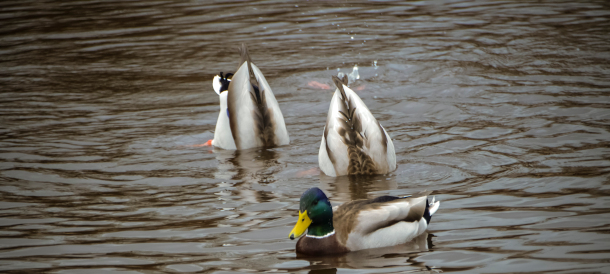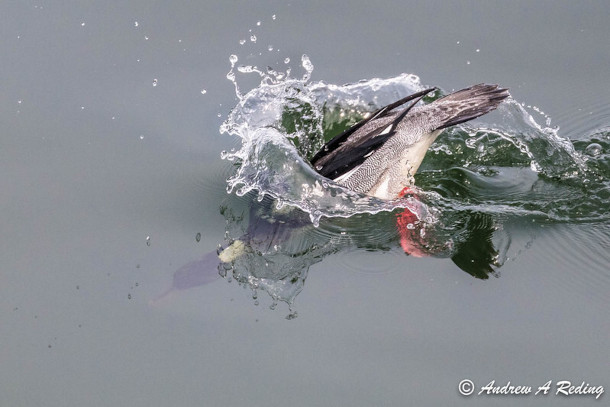BirdNote®: Ducks—-Dabbling and Diving
Air Date: Week of October 20, 2023

Mallards are “dabbling” ducks, who feed by dipping their bills in water just below the surface or dunking head-first. (Photo: cahadikin, Flickr, Creative Commons)
The fall migration in the Northern Hemisphere is a great time to keep an eye out for birds that usually live elsewhere, as BirdNote®’s Mary McCann reports.
Transcript
O’NEILL: The fall migration in the Northern Hemisphere is a great time to keep an eye out for birds that usually live elsewhere, as BirdNote®’s Mary McCann reports.
BirdNote®
Ducks - Diving and Dabbling
[Wing sounds of Surf Scoters]
Autumn brings millions of ducks flying south after nesting in the north. In most parts of North America, fall migration brings the greatest diversity of ducks we’ll see all year. Goldeneyes, scaup, wigeons and other species join familiar year-round ducks such as Mallards.
[Quacking of mallards]
Take a close look at autumn’s ducks as they forage on the water. Some dabble, while others dive.
[Whistling calls of American Wigeon]
“Dabbling ducks,” like the wigeons we’re hearing, feed by dipping their bills in water just below the surface, or dunking head first, so all you see are their tails pointing skyward.
[Whistling calls of American Wigeons]
They strain bits of vegetation and small invertebrates with their flattened bills.
“Diving ducks,” including scaup and mergansers, forage while swimming under water, using their feet or wings for propulsion. “Divers” with narrow, pointed bills snatch fish, while those with flatter bills, like Common Goldeneyes search along the bottom for invertebrates such as small clams.

A red-breasted merganser diving (Photo: Andrew Reding, Flickr, CC BY-NC-ND 2.0)
[Calls of Common Goldeneyes]
When you stop by a lake or saltwater beach this fall, keep an eye out for “dabblers” and “divers.” And take your time, because the divers may pop into view only when they need to catch a breath of air.
[More quacking and splashing]
###
Adapted by Bob Sundstrom from a script by Frances Wood
Bird sounds provided by The Macaulay Library at the Cornell Lab of Ornithology, Ithaca, New York. Recorded by A.A. Allen and W.W.H. Gunn.
Producer: John Kessler
Executive Producer: Chris Peterson
© 2014 Tune In to Nature.org September 2016/2019 October 2023
Narrator: Mary McCann
ID# duck-01c-2019-9-17 duck-01c
https://www.birdnote.org/listen/shows/ducks-diving-and-dabbling
O’NEILL: For pictures, dive into the Living on Earth website, loe dot org.
Links
Living on Earth wants to hear from you!
Living on Earth
62 Calef Highway, Suite 212
Lee, NH 03861
Telephone: 617-287-4121
E-mail: comments@loe.org
Newsletter [Click here]
Donate to Living on Earth!
Living on Earth is an independent media program and relies entirely on contributions from listeners and institutions supporting public service. Please donate now to preserve an independent environmental voice.
NewsletterLiving on Earth offers a weekly delivery of the show's rundown to your mailbox. Sign up for our newsletter today!
 Sailors For The Sea: Be the change you want to sea.
Sailors For The Sea: Be the change you want to sea.
 The Grantham Foundation for the Protection of the Environment: Committed to protecting and improving the health of the global environment.
The Grantham Foundation for the Protection of the Environment: Committed to protecting and improving the health of the global environment.
 Contribute to Living on Earth and receive, as our gift to you, an archival print of one of Mark Seth Lender's extraordinary wildlife photographs. Follow the link to see Mark's current collection of photographs.
Contribute to Living on Earth and receive, as our gift to you, an archival print of one of Mark Seth Lender's extraordinary wildlife photographs. Follow the link to see Mark's current collection of photographs.
 Buy a signed copy of Mark Seth Lender's book Smeagull the Seagull & support Living on Earth
Buy a signed copy of Mark Seth Lender's book Smeagull the Seagull & support Living on Earth

